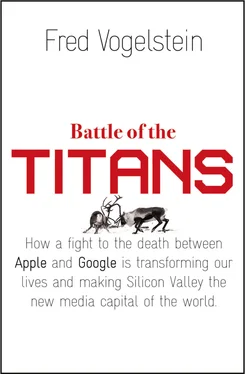Another Cingular executive who worked on the deal but who would not be named put it this way to me when I was working on a story for Wired in 2008: “Jobs was cool. He was hip. There were studies done in colleges that asked, ‘What is the one thing you can’t live without?’ For twenty years it was beer. Now it was the iPod. Things like that made us say this guy has got something. That probably gave us that much more energy to make sure this deal happened.”
While Cingular was lobbying Jobs from the outside, a handful of Apple executives, such as Mike Bell and Steve Sakoman, were pushing Jobs to sign off on building a phone from the inside. “We were spending all this time putting iPod features in Motorola phones. That just seemed ass-backwards to me,” said Bell, who now is cohead of Intel’s mobile-device effort. He told Jobs that the cell phone itself was on the verge of becoming the most important consumer electronics device of all time, that no one was good at making them, and that, therefore, “if we [Apple] just took the iPod-user experience and some of the other stuff we were working on, we could own the market.”
Bell was a perfect executive to be making this pitch. He’d been at Apple fifteen years and had helped build some of the products, such as the iMac, that enabled Apple to avoid bankruptcy in 1997. Most important, because he ran not only a chunk of the Mac software division but the software group responsible for Apple’s AirPort Wi-Fi devices, he knew more about the wireless industry than most other senior executives inside Apple. He doesn’t claim credit for being the father of the iPhone. He ultimately didn’t run or even work on the project. Fadell ran it, before Scott Forstall took it over. But even today most say Bell was an important catalyst.
“So I argued with Steve for a couple of months and finally sent him an email on November seventh, 2004,” Bell said. “I said, ‘Steve, I know you don’t want to do a phone, but here’s why we should do it: [Design director Jony Ive] has some really cool designs for future iPods that no one has seen. We ought to take one of those, put some Apple software around it, and make a phone out of it ourselves instead of putting our stuff on other people’s phones.’ He calls me back about an hour later and we talk for two hours, and he finally says, ‘Okay, I think we should go do it.’ So Steve and I and Jony [Ive] and Sakoman had lunch three or four days later and kicked off the iPhone project.”
It wasn’t just Bell’s persistence and Ive’s designs that helped convince Jobs. Sakoman came to lunch having already done some early engineering work about what it might take to build a phone. He’d been at Palm until 2003, where, among other things, he helped build the software that went inside Treo smartphones. And as vice president of software technology at Apple, he had become the executive most familiar with the software inside the iPod. If Apple was going to make a smartphone, the iPod was a logical place to start. That’s what consumers were expecting Apple to do. So by the time Sakoman arrived for lunch, he and his team had already figured out a way to put a Wi-Fi chip inside an iPod and get it to connect to the Internet.
They’d even begun working on new software for the music player—a version of Linux—so that it could handle the increased demands of being a phone and an Internet browser. Linux, the open-source software made famous by Linus Torvalds in the 1990s, had not supplanted Microsoft Windows as many geeks predicted it would. But by then it had become the software of choice for less powerful and sophisticated electronics. Sakoman briefed Jobs on his team’s progress and later that afternoon told his team, “You better start figuring this out because this [phone project] is going ahead.”
Bell says one reason why he remembers the meeting is that he’d never seen anyone eat the way Jobs did that day. “You know how you remember certain things because of their bizarreness? So we’re meeting outside at the Apple cafeteria, and when Steve walks out, on his tray is a glass bowl full of avocado halves. Not one or two, but, like, fifteen covered in salad dressing. So I remember sitting there with Jony and Sakoman and watching Steve mow through a mound of avocados. I guess, having read Walter Isaacson’s biography [of Jobs], it was one of those food phases he was in to cure his cancer, but at the time I had no idea what was up.”
The final deal between Apple and AT&T, which acquired Cingular in 2006, took more than a year to hammer out. But it would prove easy compared to what Apple went through just to build the device. Many executives and engineers, riding high from their success with the iPod, assumed it would be just like building a small Macintosh. Instead, Apple designed and built not one iPhone but three entirely different devices in those two years. One executive on the project thinks Apple made six fully working prototypes just of the device it ultimately sold—each with its own set of hardware, software, and design tweaks. Many on the team were so burned-out, they left the company shortly after the first phone hit store shelves. “It was like the first moon mission,” said Fadell, who was one of the key executives on the project, and who left Apple to start his own company, Nest, in 2010. “I’m used to a certain level of unknowns in a project, but there were so many new things here that it was just staggering.”
Jobs wanted the iPhone to run a modified version of OS X, the software that comes with every Mac. But no one had ever put 18a gigantic program like OS X on a phone chip before. The software would have to be a tenth the size, and even then there wasn’t a phone chip being made in 2005 that could run it fast enough and with a long enough battery life. The chips that run Apple laptops were never considered because they generated too much heat and would suck a phone battery dry in minutes. Millions of lines of code would have to be stripped out or rewritten, and until 2006 engineers would have to simulate chip speed and battery drain because actual chips weren’t available until then. “Initially we just worked on Gumstix boards [cheap circuit boards hobbyists buy],” said Nitin Ganatra, one of the early software engineers. “We started with the Mac address book—a list of names—and to see if we could make it scroll [on a screen] at between thirty to sixty frames a second. We just wanted to figure out if there was any way to make this [OS X on a phone chip] work—whether we were even in the right ballpark. We wanted to know if we could push bits fast enough to get that iPhone look and feel. If we couldn’t get it to work on a Gumstix board, we knew we might have a problem.”
No one had ever put a capacitive multitouch screen in a mainstream consumer product before either. Capacitive touch technology—which creates “a touch” when a finger or other conductive item completes a circuit on the device—had been around since the 1960s. Elevator buttons in office buildings and screens on ATMs often used it. And research into multitouch technologies had been around since the 1980s. Trackpads on laptops were probably the most sophisticated use of this technology because they could recognize the difference between one- and two-finger inputs. But it was also well known that to build the multitouch screen Apple put on the iPhone and produce it in volume was a challenge few had the money or guts to take on. The next steps—to embed the technology invisibly in a piece of glass, to make it smart enough to display a virtual keyboard with auto-correct, and to make it sophisticated enough to reliably manipulate content such as photos or web pages on that screen—made it hugely expensive even to produce a working prototype. Few production lines even had experience manufacturing multitouch screens. There were touchscreens in consumer electronics, but over the years these had typically been pressure-sensitive touchscreen devices on which users pushed on-screen buttons with a finger or a stylus. The PalmPilot and its successors such as the Palm Treo were popular implementations of this technology. Even if multitouch iPhone screens had been easy to make, it wasn’t at all clear to Apple’s executive team that the features they enabled, such as onscreen keyboards and “tap to zoom,” were enhancements that consumers wanted.
Читать дальше












